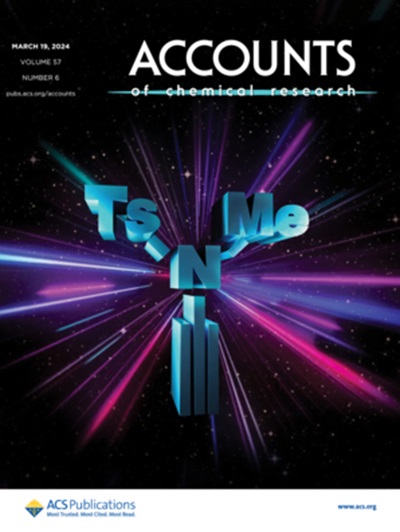核酸纳米胶囊作为基因调控治疗性核酸的新平台
IF 17.7
1区 化学
Q1 CHEMISTRY, MULTIDISCIPLINARY
引用次数: 0
摘要
治疗性核酸已经显示出巨大的潜力,可以治疗从癌症到炎症性疾病的大量疾病。2018年,在脂质纳米颗粒(LNPs)中配制的siRNA获得了FDA批准,用于治疗一种罕见的肝脏疾病,不久之后,在2020年,在LNPs中配制的mRNA成功应用,以避免全球大流行。因此,在短短几年内,无论是在学术界还是在制药行业,对核酸药物的兴趣都直线上升。尽管这些基因可编码药物令人兴奋,但要使它们成为具有潜力的药物类别,仍有许多工作要做。限制其临床潜力的主要障碍是配方无法有效地将核酸货物运送到细胞的细胞质中,这主要是由于内体包裹。此外,还存在与配方将核酸靶向特定细胞和亚细胞位置的能力相关的挑战。在这里,我们描述了我们的实验室如何使用一种与传统脂质体和LNPs明显不同的新化学制剂来解决许多这些挑战,这种新型化学制剂是自下而上构建的,专门用于使核酸货物的内体逃逸。我们从病毒那里获得了直接的灵感,目标是模仿它们的动态设计,即随着结合和内化进入细胞而发生变化,使它们能够通过局部破坏膜将遗传货物释放到细胞质中,同时保持细胞的整体完整性。本文章由计算机程序翻译,如有差异,请以英文原文为准。

Nucleic Acid Nanocapsules as a New Platform to Deliver Therapeutic Nucleic Acids for Gene Regulation
Therapeutic nucleic acids have shown enormous potential to treat a vast number of diseases, ranging from cancers to inflammatory diseases. siRNA formulated within lipid nanoparticles (LNPs) achieved FDA approval for a rare liver disorder in 2018, followed shortly after by successful application of mRNA formulated in LNPs in 2020 to stave off a worldwide pandemic. Thus, in only a few short years, interest in nucleic acid drugs has skyrocketed, both within the academic world and the pharmaceutical industry. Despite the excitement surrounding these genetically encodable medicines, there remains much work to do to enable them to be as far reaching of a drug class as they have the potential to be. The major roadblock limiting their clinical potential is the inability of formulations to efficiently deliver nucleic acid cargo to the cytosol of cells, largely due to endosomal entrapment. Additionally, there are challenges associated with the ability of formulations to target nucleic acids to specific cells and subcellular locations. Here, we describe how our lab has been working to address many of these challenges using a new chemical formulation that is distinctly different from traditional liposomes and LNPs, built from the bottom up to specifically enable endosomal escape of its nucleic acid cargo. We took direct inspiration from viruses with the goal of imitating their dynamic design that changes in response to binding and internalization into cells, enabling them to release their genetic cargo into the cytosol by locally disrupting membranes all while maintaining the cells overall integrity.
求助全文
通过发布文献求助,成功后即可免费获取论文全文。
去求助
来源期刊

Accounts of Chemical Research
化学-化学综合
CiteScore
31.40
自引率
1.10%
发文量
312
审稿时长
2 months
期刊介绍:
Accounts of Chemical Research presents short, concise and critical articles offering easy-to-read overviews of basic research and applications in all areas of chemistry and biochemistry. These short reviews focus on research from the author’s own laboratory and are designed to teach the reader about a research project. In addition, Accounts of Chemical Research publishes commentaries that give an informed opinion on a current research problem. Special Issues online are devoted to a single topic of unusual activity and significance.
Accounts of Chemical Research replaces the traditional article abstract with an article "Conspectus." These entries synopsize the research affording the reader a closer look at the content and significance of an article. Through this provision of a more detailed description of the article contents, the Conspectus enhances the article's discoverability by search engines and the exposure for the research.
 求助内容:
求助内容: 应助结果提醒方式:
应助结果提醒方式:


